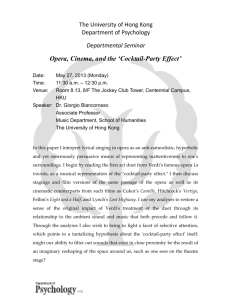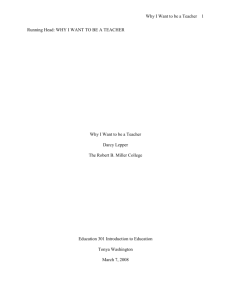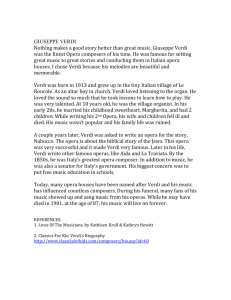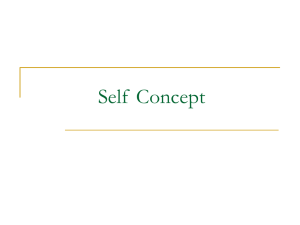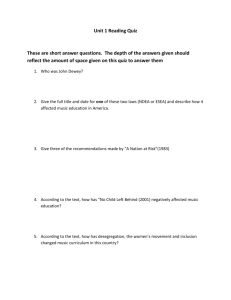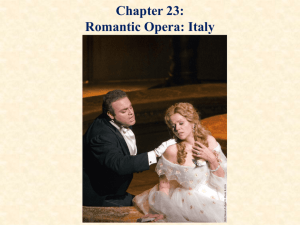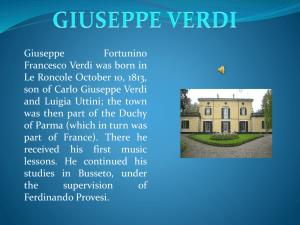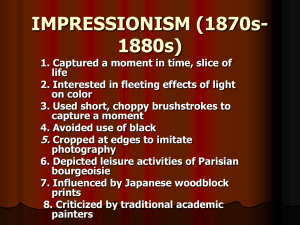The Industrial Age: The Spirit of Materialism
advertisement
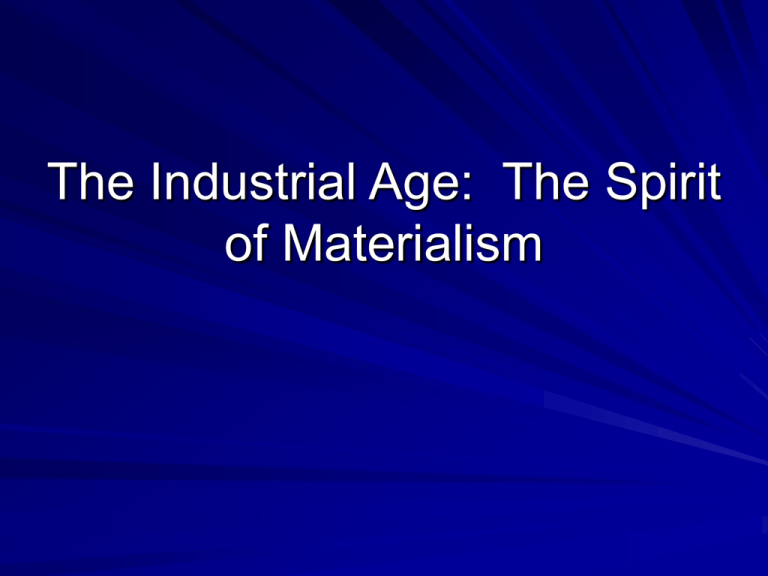
The Industrial Age: The Spirit of Materialism Materialism The belief that science, technology and industry can know all truth, solve all problems and create human happiness The Industrial Age: 1850-1910 Realism Great economic boom fueled by science and technology Railroads: symbol of progress French Revolution of 1848 (third) Realism: sober detachment and practicality; truthful and objective representation of the social world without embellishments Aim: depict society as it was Realism in Pictorial Art Courbet: enraged Parisians with his portrayal of provincial life Ordinary lives and routine events Burial at Ornans: caused a scandal Rosa Bonheur: The Horse Fair less threatening and political Photography and print-making Honore Daumier: sufferings of poor and caricatured the powerful Matthew Brady in the US photographed the cruelty of the Civil War Gaspard-Felix Tournachon, aka Nadar, made first aerial photographs Winslow Homer (children and drama at sea) and Thomas Eakins (influenced by Manet, painted rowing, sailors, swimmers): American practicality with realist technique The Realist Novel Description of industrial society: novel (dominant literary form of 19th century) Dickens: protest vs. cruelty to children David Copperfield, Oliver Twist Gustave Flaubert: Madame Bovary, naïve woman overwhelmed by modern world Other works deal with illusion and disillusionment The Spirit of Progress Material and scientific progress Victorians: optimistic about science but doubtful about the injustices brought about by their imperialism Voices of a New Age Charles Darwin: nature obeyed laws of progress; survival of fittest resulted from ‘natural selection’; Origin of the Species Social Darwinism used to justify colonial exploitation of Africa and Asia Walt Whitman celebrated the diversity of modern human life: Leaves of Grass Monuments of Progress Many architectural styles: Neoclassic, Gothic and Renaissance revivals New: The Crystal Palace, of iron and glass, built for the Great Exhibition in London, 1851 (Joseph Paxton) Iron used in bridges, industry Eiffel Tower in Paris: tallest building of world for forty years The Modern City Cities built from scratch: Washington D.C, St. Petersburg in Russia, influenced by Versailles’ rational plan and neoclassical style Paris’ challenge: Haussmann, appointed by Napoleon III to convert Paris into an imperial capital Broad boulevards and plazas, trees, spaciousness Architect Louis Sullivan, after Great Chicago Fire Designed the modern skyscraper Made possible by the elevator Steel-cage frame Floral decoration in cast iron from Art Nouveau Music and Modernity Opera house in Paris was the centerpiece of the city Verdi and Wagner – operatic geniuses Verdi’s Operas Giuseppe Verdi: National hero of Italian opera Rigoletto, Il Trovatore, La Traviata Aida: opening of the Suez Canal Used Shakespearean characters, intense emotions, and comic genius. Otello, Falstaff Emphasized action Wagner’s Musical Revolution Richard Wagner: Flamboyant, arrogant musical genius Ludwig II: built his dream opera house in Bayreuth Had love affairs with wives and daughters of patrons and colleagues Extravagant ideas: opera as the synthesis of myth, music, poetry, drama and painting Used Germanic myths and legends Innovations: a.orchestra over singing b.Leitmotif (distinct melody associated with character or object) as unifying element c. chromatic harmonies: used all twelve of the tones in a scale; dissolved traditional tonality and made his music emotional The Ring of the Niebelung: four operas (16 hours) that tell the Nordic gods’ tales Late Romantic Music and Dance Brahms: Disciple of Beethoven; last “great” composer Smetana: The Moldau Tchaikovsky: 1812 Overture, Swan Lake, Sleeping Beauty Marius Petipa-- first great choreographer for classical ballet Modernity The process by which the new, up-to-date, and the contemporary replace the outmoded and traditional. Artists turned against modernity Baudelaire and Marllame(French poets) Dostoyevsky (Russian novelist) The Last Romantics Anticipated the coming artistic techniques: Poetry: enigmatic symbolism Visual Arts: plants and designs of Art Nouveau Music: Debussy Sculpture: Rodin’s figures Symbolism and Art for Art’s Sake Baudelaire: his poetry explored connections between sordid and sublime; erotic Rejected values of industrial society L’art pour l’art art parallel to the world in a separate universe Art Nouveau Style of decorative art and architecture that used floral motifs and stressed unity of materials and form Tiffany’s colored glass Antonio Gaudi: Buildings, churches and parks in Barcelona Debussy’s Musical Impressions His works explored new harmonies Evoke dream-like moods and impressions Prelude to the Afternoon of a Faun Discarded conventional harmony Rodin Broke with the commemorative public sculpture: Bartholdi’s Statue of Liberty The Gates of Hell: from Dante’s Inferno Tortured figures The Thinker: Dante Balzac was rejected Art was private and subjective Impressionism and Beyond Artists wanted to paint modern life Impressions of the moment Defined new techniques of light, color and visual form Precursor : Manet Luncheon on the Grass Violated painterly tradition Bar at the Folies-Bergere Monet and the Impressionists Paintings rejected by official Salon 1874: own exhibition Impression: Sunrise, St. Lazare Train Station Monet Use of light, color, spontaneous technique, detachment and innovative design Renoir, Morisot, Degas, Pissarro, Cassatt Morisot View of Paris from the Trocadero Discarded conventional subject Light and motion Open air Did not mix paints before applying them No didactic purpose Renoir More poetic/emotional than Monet Informal mood of city life Le Moulin de la Galette Accidental pattern of yellow straw hats and prints of women’s dresses Influenced by Michelangelo in his later years Degas/Cassatt Arbitrary framing of his subjects Off-center The Dancer in Green, ballet scene Influenced by Japanese prints Friends with the American Mary Cassatt Flattened perspective The Boating Party Post-Impressionism: Seurat Post-Impressionists extended impressionist techniques in different directions Seurat: closest to Monet’s pure impressionism Urban life, unmixed colors directly applied Sunday Afternoon on the Island of la Grande Jatte pointillism Cezanne Mont Saint-Victoire, in the Mediterranean Explored the essence of reality Reduced objects to their basic geometric pattern Precursor to modern painting, abstract and cubist art: Picasso Gauguin Wanted to express human feeling, to enter “the mysterious center of thought.” Primitives of Brittany, northwest France Sought unique and picturesque Unnatural colors, heavy lines and flattened shapes: precursor to surrealism, Dali The Vision after the Sermon, Self-Portrait with Halo Van Gogh Early: sympathy for the plight of peasants Influenced by impressionists Uses colors to convey strong emotions Starry Night: swirling lines convey violent energy Vivid colors, paint applied thickly, with knife. Influenced by Japanese art Precursor to abstract expressionism The Dark Side of Progress Colonial oppression in Asia and Africa Chekhov and Ibsen explored realms of psychology and symbolism Dostoyevsky: conflicts between belief and doubt Nietzsche: elite race of supermen to rule mass society The Realist Theater Chekhov: The Three Sisters; The Cherry Orchard Ibsen: The Wild Duck; Hedda Gabler; A Doll’s House The Novel and Modern Philosophy Late 19th century novel focused on inner lives Henry James Edith Wharton Fyodor Dostoyevsky: Crime and Punishment; The Brothers Karamazov; The Idiot Nietzsche: Thus Spake Zarathustra Anticipated the theories of Freud
